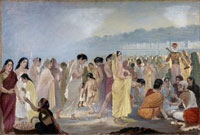Archives in Transition
Tekton
Volume 11, Issue 2, December 2024
pp. 94 – 98
Hemangi Kadu
‘Shifting Visions: Teaching Modern Art at the Bombay School’ is a compelling exhibition exploring the early years of Mumbai’s Sir J.J. School of Art, Architecture and Design. Curated with sensitivity and scholarly rigor, the exhibition is not merely a historical overview, but a dynamic reevaluation of how artistic pedagogy both influenced and was influenced by modern Indian art practices. At its core, Shifting Visions reflects on how formal art education, introduced and structured during the colonial era, laid the groundwork for India’s engagement with modernism. Through a striking mix of student works, sketches, and archival material alongside masterpieces from the DAG collection and school archives, it offers a rich narrative and critique of institutional impact on artistic identity, highlighting stylistic, ideological, and social shifts in artistic expression.

At Chowpaty Beach Oil on Canvas By M.V. Dhurandhar (c.1934)
Exhibition Title: ‘Shifting Visions: Teaching Modern Art at the Bombay School’ (2025)
Venue: Sir J.J. School of Art, Architecture and Design From 07 March-20 April 2025
The Sir J.J. School of Art, founded in the mid-19th century, occupies a unique place in the history of Indian art. Originally established with a colonial mission of imparting European artistic techniques to Indian students, the school gradually transformed into a crucible of indigenous expression. This transformation is central to the exhibition’s theme. The early curriculum was modeled on European academic traditions, with an emphasis on naturalistic representation, anatomy, perspective, and idealized beauty. The early sections of the exhibition echo this aesthetic with a remarkable series of classical portraiture—meticulously rendered academic studies of plaster casts, Greco-Roman heads, and life-size oil portraits. These are stunning in their technical precision and offer a clear glimpse into the formal expectations placed upon students at the time. These works speak to a collective discipline and silent labor involved in the training.
Yet, what is most striking is the way these exercises, initially intended to instill conformity, became the foundation upon which several generations of Indian artists built distinct, regionally rooted and self-aware practices. The exhibition’s layout, which flows between chronological and thematic sections, helps illustrate this shift—from the mastery of European techniques to the gradual appropriation and reinterpretation of these forms to reflect local realities, folklore, and socio-political themes. The presence of rigorous academic works in the exhibition adds depth to the narrative of modernism’s eventual emergence—they show what artists had to first master in order to later unlearn.
Integral to this unlearning—and one of the exhibition’s pivotal themes—is the arrival of Charles Gerard as a key figure in the school’s history. Gerard, an educator and artist in the early 20th century, served as Principal of the J. J. School and is widely credited with initiating the shift toward modernist sensibilities in Indian art education. The exhibition features works from students who studied under his tenure—sketches and paintings that reflect a growing engagement with expressionism, abstraction, symbolism, and experimentation with color and form. Gerard’s impact is not just visible in the visual language of these pieces but in their conceptual frameworks—students began to engage with local subjects through a modernist lens, moving away from colonial mimicry and toward introspection and cultural critique. This led to the formation of a new league of artists called Young Turks, or the Pre- Progressive Group.
In addition to these luminaries, Shifting Visions is notable for recovering lesser-known voices—artists who may not have achieved national fame but were active participants in the artistic ferment of the time. The inclusion of student exhibition catalogues, award certificates, news clippings from the Bombay Art Society’s annual shows and the photographs of the tea parties at the campus, helps reconstruct the artistic ecosystem that flourished around the school. These materials reveal how students, teachers, critics, and patrons intersected in a dynamic cultural field, especially in the rapidly modernizing city of Bombay. The old photographs of classrooms and studios add another rich layer of understanding the educational environment that was, reminding viewers of the many unnamed artists whose journeys were shaped within those institutional walls.
Further depth is added through the inclusion of principals and faculty who left indelible marks on the institution. Figures such as Cecil Burns, Gladstone Solomon and Lockwood Kipling are acknowledged for their roles in refining the curriculum and supporting Indian artists within a colonial framework. The extensive display of drawings from the frescoes of Ajanta caves made by students under the guidance of John Griffiths in the 1880s proves how crucial they were in spreading awareness and appreciation of Indian Art. By the 1930s and ’40s, however, Indian faculty members began to assert greater control over the school’s direction, coinciding with the growing nationalist movement. The viewer gains a sense of how the school responded to such winds of change.
One of the exhibition’s highlights is the presentation of student academic drawings alongside their mature works. These pairings function as windows into the artists’ developmental trajectories. A viewer might observe how a sketch that captures light and form of a plaster cast by M.V. Dhurandhar made during student years evolves decades later into an atmospheric composition of sensuous forms imbued with cultural identity set in a local landscape. We further see his trajectory towards more complex narrative paintings filled with nationalist symbolism or spiritual undertones. Such moments in the show are profound, as they emphasize not just technical growth but also ideological shifts—how art moved from serving colonial aesthetics to becoming a medium of cultural assertion and introspection.
The curatorial team deserves credit for resisting the temptation to present this shift as linear or inevitable. Instead, they present it as a complex negotiation—between teacher and student, tradition and rebellion, West and East. Works are grouped to encourage comparison and reflection, and textual material—wall labels, timelines, and catalog notes—is wellresearched and accessible. The exhibition avoids didacticism; instead, it invites inquiry. A section devoted to studio practices, for example, includes interactive setups that welcome the audience to get in the shoes of an artist and engage in the process of creation. Display of materials like charcoal, palettes, and easels, evoke the physicality of artistic labor involved.
If there is a limitation, it is perhaps the sheer breadth of the subject, which at times makes the exhibition feel dense. Some viewers may find themselves overwhelmed by the volume of information and the nuanced layers of comparison. However, this speaks more to the complexity of the topic than to any curatorial shortcoming. The choice to embrace that complexity rather than oversimplify is ultimately a strength.
Shifting Visions is not just a retrospective on an institution—it is a meditation on artistic formation itself that offers us a timely and locally resonant case study for comprehending the global art discourse. It is also, crucially, a reminder that pedagogy matters. That the spaces in which artists are trained—their classrooms, studios, and critique sessions—are not neutral. They are sites of transformation. And through the legacy of figures like Cecil Burns, John Griffiths, Gladstone Solomon, Charles Gerard, Walter Langhammer, and the myriad students who passed through the J. J. School’s halls like M.V. Dhurandhar, Abalal Rahman, Pestonji Bomanji, V.S. Adurkar, T.P. Reddy, F.N. Souza and others, we come to see how teaching itself can be a radical act.
To visit Shifting Visions is to stand at the confluence of tradition and transformation. It compels us to ask: what does it mean to teach art? What is preserved and what is lost in formal training? And how do institutions, alongside inculcating rigorous academic discipline, become spaces of resistance, experimentation, and identity formation?
In sum, Shifting Visions: Teaching Modern Art at the Bombay School is a landmark exhibition—rich in detail, ambitious in scope, and deeply moving in its implications. It is an essential experience for anyone interested in the story of modern Indian art and the quiet revolutions that take place in the space between a teacher’s guidance and a student’s vision.
It reveals how vision is not just taught—it is contested, shaped, resisted, and ultimately, shifted.
 Hemangi Kadu is an educator, fine artist, and a photographer based in Mumbai. She holds a Masters degree in Architecture by Research from Sir J. J. College of Architecture. Following her passion for the arts, Hemangi expanded her artistic repertoire by graduating in Fine Art – Drawing & Painting (Classical training in Figurative Art) in 2022 from the Barcelona Academy of Art in Spain. She has held about 3 solo exhibitions in the city, and has also participated in group exhibitions at notable venues, including the Jehangir Art Gallery, NCPA Piramal Art Gallery, TARQ Gallery in Mumbai, Mutuo Centro Gallery and Toolip Gallery in Barcelona. Presently, she is an Assistant Professor at Pillai College of Architecture.
Hemangi Kadu is an educator, fine artist, and a photographer based in Mumbai. She holds a Masters degree in Architecture by Research from Sir J. J. College of Architecture. Following her passion for the arts, Hemangi expanded her artistic repertoire by graduating in Fine Art – Drawing & Painting (Classical training in Figurative Art) in 2022 from the Barcelona Academy of Art in Spain. She has held about 3 solo exhibitions in the city, and has also participated in group exhibitions at notable venues, including the Jehangir Art Gallery, NCPA Piramal Art Gallery, TARQ Gallery in Mumbai, Mutuo Centro Gallery and Toolip Gallery in Barcelona. Presently, she is an Assistant Professor at Pillai College of Architecture.
Email: kaduhemangi@gmail.com

